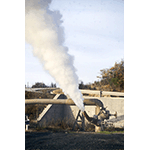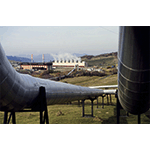Museo della Geotermia Enel [Enel Museum of Geothermal Energy]
«Monte Cerboli - as described by Grand Duke Peter Leopold of Lorraine - is a small manor of from 3 to 400 souls. A mile further on, and for a radius of a mile, in a grassy valley lie very large apertures and various fumaroles […]. Water no longer boils in many of them, while others are dry and only smoke; many are ponds with water boiling violently, and in others, the water noisily gushes forth to a height of 4 or 5 arms; in many, one can only hear the wind roar forth from underground. They are subject to constant change, and while some die out, other new ones are born».
The natural manifestations of the area of Larderello (lagoni, fumaroles and hot springs) were already known to the Etruscans and Romans, who utilised boron salts for pharmaceutical purposes and to prepare enamels. In the Middle Ages and the Renaissance, the thermal and pharmaceutical use of the waters continued.
Following the discovery of boric acid in the lagoni (mud volcanoes) of Volterra by chemist Uberto Francesco Hoefer, director of the grand-ducal pharmacies), the first attempts at economic exploitation were begun. The great anatomist Paolo Mascagni, born in Pomarance, supplied an efficient description of the lagoni: «Lagoni are plots of land in the areas of Volterra and Siena, which have larger or smaller dimensions, are without plant life, and have depressions containing water that boils more or less noisily, while a white cloud or varyingly dense steam rises from the surface, becoming smoke that disperses in the air and spreads a strong odour of liver of sulphur over a great distance. Because of this smoke, in several places they are called fumaroles, while in others, such as Viterbo, mud volcanoes».
In 1818, tradesman of French origin Francesco Giacomo Larderel set up near Montecerboli the first industrial nucleus for the production of borax. In the span of a few decades, thanks to continuous technical innovations, the borax industry became an advanced model on the industrial and technological panorama of Tuscany. So it was that in 1846, Grand Duke Leopold II of Lorraine paid homage to the founder of the borax industry by giving the name of Larderello to a town in the area. Other factories were built at Lustignano, Serrazzano, Monterotondo, Castel Nuovo, Sasso and Lago.
The fumaroles are currently utilised in the geothermal-electric energy sector. The first historical experiment in the production of geothermal-electric energy dates July 4, 1904 when a piston engine, driven by steam obtained in a heat exchanger, powered by a steam well at Larderello and connected to a 10 kilowatt dynamo, lit five light bulbs of a few watts each, which made it possible to verify that energy could be produced by means of geothermal fluids. In 1913, the world’s first geothermal plant was set up.
The history of the borax industry and of the industrial exploitation of geothermal energy has been reconstructed, thanks to a detailed and interesting iconographic, documentary and instrumental apparatus by the Geothermal Energy Museum, founded in 1956 by Larderello Spa. The origin of the Museum date to the small popular exhibition set up in Palazzo De Larderel in the late 19th century. Today, the property belongs to ENEL Greenpower Spa, and the Museum is housed in a temporary structure (a geodesic dome), while awaiting the conclusion of the restoration of Palazzo De Larderel.
The collection is made up of historical exhibits, datable from the mid 19th to the mid 20th century, tied to the exploitation of the borax springs. It includes samples of minerals and rocks, drilling machinery, electric power plant machinery, and various scientific apparatuses, including the instruments of the old Larderello pharmacy. The collection also comprises models concerning the development of the Larderello area, the extraction methods of boric acid, the drilling activities and the production of electric energy. It furthermore presents the company books, geological maps and documentation concerning (the) production activity. The Museum library and archive are on deposit care of the ENEL historical archive in Florence.
****************************
Texts by Graziano Magrini
English translation by Victor Beard
Last update 11/feb/2008





